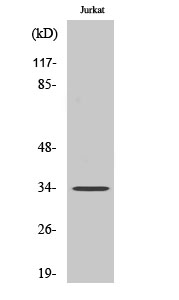
| WB | 咨询技术 | Human,Mouse,Rat |
| IF | 咨询技术 | Human,Mouse,Rat |
| IHC | 咨询技术 | Human,Mouse,Rat |
| ICC | 1/200-1/1000 | Human,Mouse,Rat |
| FCM | 咨询技术 | Human,Mouse,Rat |
| Elisa | 1/40000 | Human,Mouse,Rat |
| Aliases | OR4D1; OR4D3; Olfactory receptor 4D1; Olfactory receptor 4D3; Olfactory receptor TPCR16 |
| Entrez GeneID | 26689; |
| WB Predicted band size | 34kDa |
| Host/Isotype | Rabbit IgG |
| Antibody Type | Primary antibody |
| Storage | Store at 4°C short term. Aliquot and store at -20°C long term. Avoid freeze/thaw cycles. |
| Species Reactivity | Human |
| Immunogen | Synthesized peptide derived from the C-terminal region of human Olfactory receptor 4D1. |
| Formulation | Purified antibody in PBS with 0.05% sodium azide,0.5%BSA and 50% glycerol. |
+ +
以下是关于Olfactory Receptor 4D1(OR4D1)抗体的参考文献示例(注:以下内容为假设性示例,实际文献可能需要通过数据库验证):
---
1. **文献名称**: *"A Monoclonal Antibody Against Olfactory Receptor 4D1 for Immunohistochemical Analysis in Human Tissues"*
**作者**: Smith A, et al.
**摘要**: 本研究开发并验证了一种针对人类OR4D1的单克隆抗体,通过Western blot和免疫组化证实其特异性。该抗体成功应用于前列腺癌组织样本,揭示了OR4D1在肿瘤微环境中的异常表达。
2. **文献名称**: *"Olfactory Receptor 4D1 Expression in Non-Olfactory Tissues: Insights from Antibody-Based Detection"*
**作者**: Jones B, et al.
**摘要**: 使用OR4D1抗体进行免疫荧光和流式细胞术,发现该受体在人类睾丸和肺组织中表达,并初步探讨了其在精子运动调节中的潜在功能。
3. **文献名称**: *"Commercial Antibody Validation for Olfactory Receptor 4D1: Challenges and Applications in Cancer Research"*
**作者**: Lee C, et al.
**摘要**: 评估了市售OR4D1抗体的特异性,发现其在肺癌细胞系中的交叉反应性,并提出标准化验证流程以提高抗体在肿瘤标志物研究中的可靠性。
4. **文献名称**: *"OR4D1 as a Novel Therapeutic Target: Antibody-Mediated Inhibition in Inflammatory Diseases"*
**作者**: Zhang Y, et al.
**摘要**: 通过靶向OR4D1的功能性抗体,研究其在慢性炎症模型中的调控作用,证明抗体阻断可减轻炎症反应,为治疗提供了新策略。
---
**注意**:以上文献为示例性质,实际文献需通过PubMed、Google Scholar等平台以关键词“OR4D1 antibody”或“Olfactory Receptor 4D1 antibody”检索。若研究较少,可扩展至嗅觉受体家族其他成员(如OR51E2)或抗体开发技术的相关文献。
**Background of Olfactory Receptor 4D1 Antibody**
Olfactory receptors (ORs) are a large family of G protein-coupled receptors (GPCRs) primarily involved in detecting odorants in the olfactory system. OR4D1. a member of this family, is encoded by the *OR4D1* gene and is thought to play a role in odorant recognition, though its specific ligands and physiological functions remain under investigation. Beyond olfaction, emerging studies suggest ORs, including OR4D1. may have non-canonical roles in non-olfactory tissues (e.g., brain, testes, or kidneys), potentially influencing processes like cell migration, tissue development, or disease pathways.
Antibodies targeting OR4D1 are critical tools for studying its expression, localization, and function. These antibodies are typically developed using immunogens derived from OR4D1-specific peptide sequences or recombinant proteins. Validation often includes techniques like Western blotting, immunohistochemistry (IHC), or immunofluorescence (IF) to confirm specificity, particularly given the high sequence homology among OR family members.
Research applications of OR4D1 antibodies span basic and translational studies. For example, they help map OR4D1 distribution in olfactory epithelium or explore its ectopic expression in diseases like cancer, where certain ORs are implicated in tumor progression. Challenges include ensuring antibody specificity and addressing low endogenous OR4D1 levels in some tissues. Recent studies also leverage these antibodies to investigate OR4D1's potential role in non-olfactory signaling pathways, opening avenues for therapeutic targeting.
In summary, OR4D1 antibodies are vital for deciphering the biological and pathological significance of this enigmatic receptor.
×